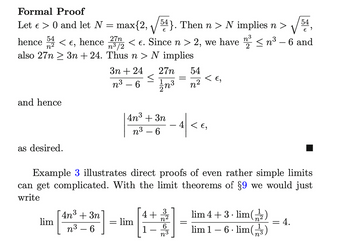3. Use the definition of convergence to prove lim Ross 9 is allowed. 4. Use the definition of convergence to prove lim Ross 9 is allowed. 3n n+1 n² +1 = 3; no theorem in = = 0; no theorem in
3. Use the definition of convergence to prove lim Ross 9 is allowed. 4. Use the definition of convergence to prove lim Ross 9 is allowed. 3n n+1 n² +1 = 3; no theorem in = = 0; no theorem in
Calculus: Early Transcendentals
8th Edition
ISBN:9781285741550
Author:James Stewart
Publisher:James Stewart
Chapter1: Functions And Models
Section: Chapter Questions
Problem 1RCC: (a) What is a function? What are its domain and range? (b) What is the graph of a function? (c) How...
Related questions
Question

Transcribed Image Text:3. Use the definition of convergence to prove lim 3n
Ross 9 is allowed.
n+1
=
3; no theorem in
n-1
4. Use the definition of convergence to prove lim 21 = 0; no theorem in
Ross 9 is allowed.
n²+1
Expert Solution
Step 1: Given
3)lim 3n/(n+1)
4)lim (n-1) /(n2+1)
Trending now
This is a popular solution!
Step by step
Solved in 3 steps with 1 images

Follow-up Questions
Read through expert solutions to related follow-up questions below.
Follow-up Question
can you use the form in picture to proof them?

Transcribed Image Text:Formal Proof
Let e > 0 and let N =
54
max{2, ¹}. Then n > N implies n > € 9
54
27n
hence 2 < €, hence < €. Since n > 2, we have 2³ ≤ n³ – 6 and
n³/2
n²
also 27n3n+24.
Thus n > N implies
and hence
as desired.
lim
3n+24
n³-6
4n³ + 3n"
3
n³-6
<
=
= lim
27n
1/1/n³
3
4n³ + 3n
n³-6
Example 3 illustrates direct proofs of even rather simple limits
can get complicated. With the limit theorems of §9 we would just
write
4+
1
=
n3
54
n²
< €₂
4 < €,
=
lim 4+ 3. lim(2)
lim 1-6. lim(3)
= 4.
Solution
Similar questions
Recommended textbooks for you

Calculus: Early Transcendentals
Calculus
ISBN:
9781285741550
Author:
James Stewart
Publisher:
Cengage Learning

Thomas' Calculus (14th Edition)
Calculus
ISBN:
9780134438986
Author:
Joel R. Hass, Christopher E. Heil, Maurice D. Weir
Publisher:
PEARSON

Calculus: Early Transcendentals (3rd Edition)
Calculus
ISBN:
9780134763644
Author:
William L. Briggs, Lyle Cochran, Bernard Gillett, Eric Schulz
Publisher:
PEARSON

Calculus: Early Transcendentals
Calculus
ISBN:
9781285741550
Author:
James Stewart
Publisher:
Cengage Learning

Thomas' Calculus (14th Edition)
Calculus
ISBN:
9780134438986
Author:
Joel R. Hass, Christopher E. Heil, Maurice D. Weir
Publisher:
PEARSON

Calculus: Early Transcendentals (3rd Edition)
Calculus
ISBN:
9780134763644
Author:
William L. Briggs, Lyle Cochran, Bernard Gillett, Eric Schulz
Publisher:
PEARSON

Calculus: Early Transcendentals
Calculus
ISBN:
9781319050740
Author:
Jon Rogawski, Colin Adams, Robert Franzosa
Publisher:
W. H. Freeman


Calculus: Early Transcendental Functions
Calculus
ISBN:
9781337552516
Author:
Ron Larson, Bruce H. Edwards
Publisher:
Cengage Learning